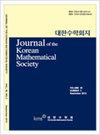高斯收缩孤子上双漂移拉普拉斯算子的低阶特征值
IF 0.5
4区 数学
Q2 MATHEMATICS
引用次数: 0
摘要
在一般完备度量空间的有界域上证明双漂移拉普拉斯算子的特征值不等式Payne-Pólya-Weinberger是非常困难的。即使我们假设微分算子在标准欧几里得球上是双调和的,这个问题仍然没有解决。然而,在一定条件下,本文建立了双漂移拉普拉斯特征值的一般不等式,从而证明了高斯收缩孤子上双漂移拉普拉斯低阶特征值的Ashbaugh-Cheng-Ichikawa-Mametsuka型特征值不等式(也称为Payne-Pólya-Weinberger型特征值不等式)。本文章由计算机程序翻译,如有差异,请以英文原文为准。
Lower order eigenvalues for the bi-drifting Laplacian on the Gaussian shrinking soliton
It may very well be difficult to prove an eigenvalue inequality of Payne-Pólya-Weinberger type for the bi-drifting Laplacian on the bounded domain of the general complete metric measure spaces. Even though we suppose that the differential operator is bi-harmonic on the standard Euclidean sphere, this problem still remains open. However, under certain condition, a general inequality for the eigenvalues of bidrifting Laplacian is established in this paper, which enables us to prove an eigenvalue inequality of Ashbaugh-Cheng-Ichikawa-Mametsuka type (which is also called an eigenvalue inequality of Payne-Pólya-Weinberger type) for the eigenvalues with lower order of bi-drifting Laplacian on the Gaussian shrinking soliton.
求助全文
通过发布文献求助,成功后即可免费获取论文全文。
去求助
来源期刊
CiteScore
1.20
自引率
16.70%
发文量
0
审稿时长
6-12 weeks
期刊介绍:
This journal endeavors to publish significant research of broad interests in pure and applied mathematics. One volume is published each year, and each volume consists of six issues (January, March, May, July, September, November).

 求助内容:
求助内容: 应助结果提醒方式:
应助结果提醒方式:


